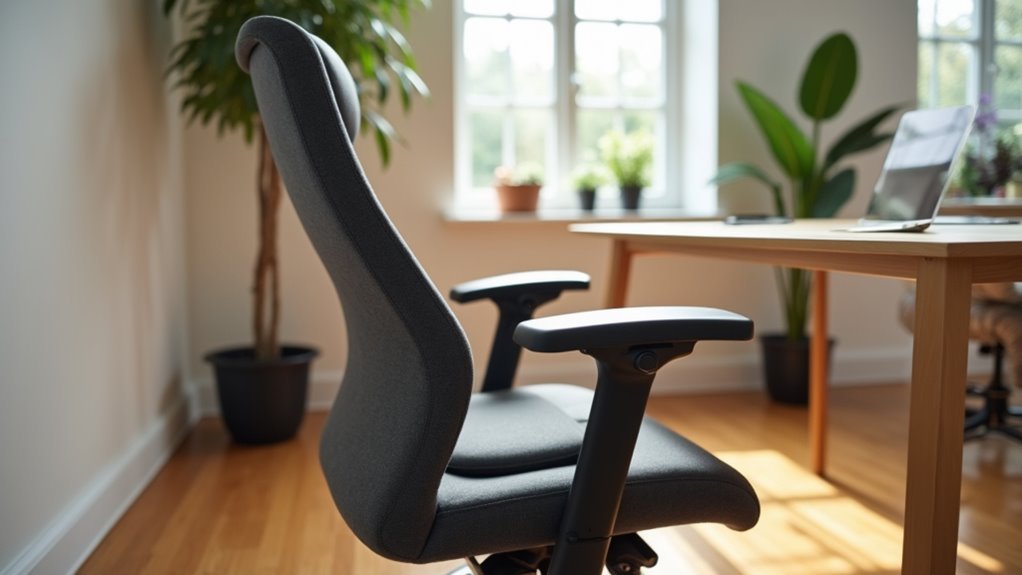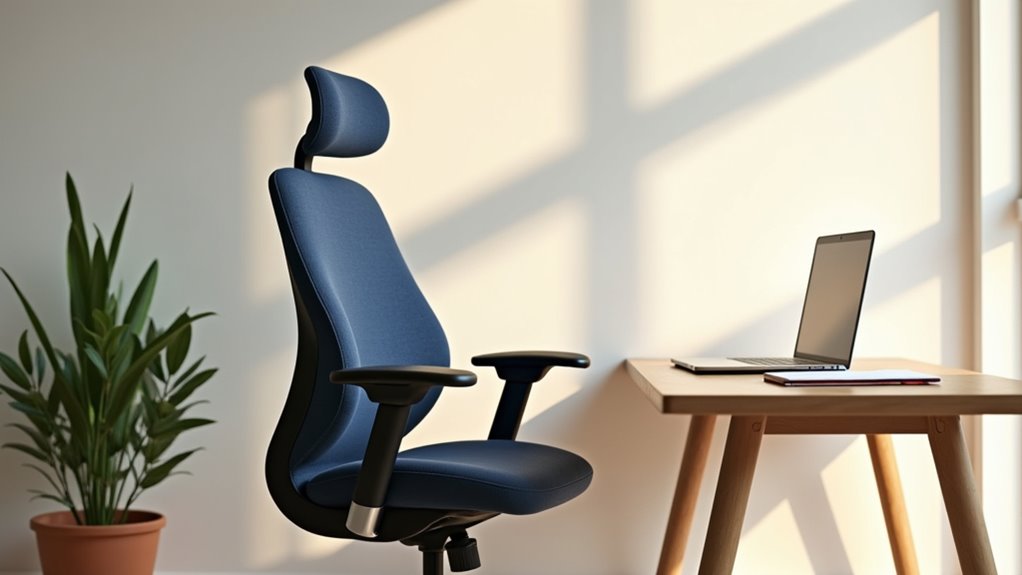How to Correctly Sit in a Chair
This post contains affiliate links. As an Amazon Associate, we earn from qualifying purchases.
To sit correctly in a chair, ensure your feet are flat on the floor and your knees are at a 90-degree angle. Utilize lumbar support to maintain a straight back and sit fully back in the chair. Keep your elbows close to your body, bent at about 100 degrees, and allow your wrists to rest flat while typing. It’s important to shift your position occasionally to stay comfortable and energized. For those looking for more detailed guidance, additional tips will follow.
Essential Facts in 30 Seconds
- Adjust chair height for flat feet and 90-degree knee angle.
- Use lumbar support 6-10 inches above the seat for spinal alignment.
- Keep elbows close, bent at 90 to 120 degrees, with flat wrists while typing.
- Sit fully back in the chair, with a small gap between the seat and knees.
- Change position every 15 minutes and take breaks every 30-60 minutes to enhance circulation and reduce fatigue.
Optimal Seat Height and Leg Position
Finding the right seat height and leg position makes a big difference. A comfy chair helps you work or relax better. Aim for a chair height between 16 to 21 inches. Your feet should rest flat on the floor. Knees should bend at a 90-degree angle. This setup keeps you feeling good. Ergonomic importance promotes user comfort, health, and productivity. Chair height adjustment is crucial for preventing slouching and ensuring proper support. Choosing a chair with lumbar support can further enhance your sitting experience. Additionally, adjusting the chair height correctly can reduce strain on your back and legs.
Adjustable chairs are great. You can change the height to fit your needs.
Next, focus on leg positioning. Your knees should be level with or slightly below your hips. This helps with blood flow and comfort. Feet should stay flat or on a footrest. This reduces pressure on your legs.
At first, adjusting your chair might feel tricky. Keep trying until you find the perfect height. Once you do, you’ll sit comfortably and be ready to tackle your day. Enjoy your time at your desk!
Supporting Your Back and Lumbar

Your back needs special care while you sit. Getting it right matters a lot!
Start by using lumbar support. Cushions or adjustable chair backs help your spine stay aligned. Place it snugly in the small of your back, about 6-10 inches above the seat. It should fit your natural curve. This way, you avoid slouching. Poor posture is a common cause of lower back pain, so maintaining proper alignment is crucial. Additionally, using lumbar support can help reduce strain on your back over time. Proper ergonomics also contribute to a healthier sitting experience. Good posture can significantly enhance your comfort and productivity while seated.
Sit all the way back in your chair. Let the support do its job. A small gap between the seat edge and the back of your knees is good. Aim for about 2-4 fingers wide. This keeps your hips comfortable.
If you feel pressure or lean forward, make some quick changes. Your lumbar support should keep you comfy and your back healthy. Keep that good posture!
Proper Shoulder, Arm, and Neck Alignment
Getting your back comfy with lumbar support is just the start.
Next, focus on your shoulders, arms, and neck. Relax your shoulders. Keep them down to avoid stress and tension. Gently pull your shoulder blades together. Imagine you’re pinching a pencil between them. This helps your upper back stay aligned.
Now, let’s adjust your arms. Keep your elbows close to your body. Bend them at about 90 to 120 degrees. Make sure your wrists stay flat while typing. Your keyboard should be at a height that keeps your forearms parallel to the floor. Proper alignment is essential for reducing strain on muscles and ligaments. Proper back support also plays a crucial role in maintaining this alignment.
For head alignment, tuck your chin slightly. This helps keep everything lined up. Your monitor should be at eye level. This way, you won’t crane your neck.
Don’t forget to take breaks to stretch. This keeps your neck feeling fresh. You can do this! Taking breaks every 30-60 minutes is recommended to help reduce fatigue and promote better circulation.
Importance of Movement and Posture Dynamics

Sitting still might seem comfortable, but moving a bit each day really helps your body. Shifting your position every 15 minutes gives your spine a mini workout. This helps remove waste and keeps your spinal tissues healthy. Additionally, proper sitting posture is crucial for maintaining your overall health. Regularly adjusting your chair can ensure adequate lumbar support for your spine.
Movement also benefits your joints, keeping them flexible and lubricated. No need for jumping jacks in your chair. Just adjusting your posture or wiggling can make a difference. Active sitting options, like balance ball chairs, help engage your muscles while you work. Remember, it’s all about posture dynamics. Keep moving to boost blood flow and feel more energetic. Additionally, regular breaks from prolonged sitting can significantly reduce stiffness and discomfort.
Choosing the Right Chair and Sitting Surface
Choosing the right chair and sitting surface can greatly improve your comfort. A good chair makes sitting for long hours easier. Here are three important things to think about:
- Seat Design: A chair with a waterfall front edge helps reduce pressure behind your knees. It should match your body shape and support most of your thigh.
- Chair Materials: Choose materials that feel soft but still provide support. This helps spread your weight evenly and keeps you comfortable.
- Height Adjustability: Adjust the chair height so your knees sit slightly lower than your hips. This keeps your back in a good position and prevents stress. Additionally, ensure that your chair has lumbar support to promote a natural spine curve and reduce strain.
Remember to look for lumbar support for your lower back.
With the right chair, you can enjoy sitting much more!
Frequently Asked Questions
How Can I Tell if My Chair Is the Right Size?
To find the right size chair, check its dimensions. The seat height should let your feet rest flat on the floor. Your knees need to be at a comfortable 90-degree angle. This position gives you the best support.
A chair that’s too high or too low can cause discomfort. Make sure the seat depth allows your back to rest against the backrest. Your back should feel supported, not strained.
Also, think about armrests. They should support your arms without lifting your shoulders. A good chair helps you sit comfortably for long periods.
Measure your desk height too. The chair and desk should work well together. A good match helps you stay focused and productive.
What Are the Signs of Poor Sitting Posture?
Slouching shows clear signs of poor sitting posture. Look for rounded shoulders and a head that leans forward. Neck strain or pain often means your posture needs fixing. Good posture helps avoid long-term health problems. Sit up straight and align your head with your spine. These small changes can make a big difference. Remember, sitting well is important for your overall health.
How Often Should I Take Breaks While Sitting?
Taking breaks is important for your health. Aim for a 1-minute break every 30 minutes. Or take a longer 5-minute break. Regular breaks help you stay energized. They also improve your focus throughout the day. Sitting for too long can cause problems. It can lead to fatigue and discomfort. Breaks help reduce these issues. Stand up, stretch, or walk around. Your body and mind will thank you. Stay active for better health!
Can Sitting Incorrectly Lead to Long-Term Health Issues?
Sitting incorrectly can cause long-term health problems. Bad posture can lead to back pain. It may also cause digestive issues. Over time, poor sitting habits increase the risk of musculoskeletal disorders. Heart problems can also arise from not sitting properly.
Good posture is important for your overall health. It helps keep your spine aligned. This can reduce pain and discomfort. Proper sitting can also improve your focus and energy levels. Remember to sit up straight and keep your feet flat on the floor. Adjust your chair to support your back. Small changes can make a big difference. Prioritize your health by sitting correctly each day.
What Should I Do if My Chair Causes Discomfort?
A chair that feels uncomfortable can ruin your day. Start by adjusting it for better comfort. Check the cushion support. Make sure it fits your body well. Good lumbar support is key. It helps your back stay straight. Sometimes, small changes make a big difference.
Take breaks often. Stand up and stretch your legs. This helps blood flow and reduces stiffness. Use a footrest if your feet don’t touch the ground. Keep your monitor at eye level. This helps you sit straight.
Invest in a good chair if you can. Look for one designed for long hours. Remember, comfort matters for your health and focus. A happy chair leads to a happy you.
Conclusion
Sitting correctly in a chair is important for comfort and health. Start by adjusting the chair height. Your feet should rest flat on the floor. This helps keep your spine aligned.
Support your lower back with a cushion or the chair’s built-in support. Sit up straight, with shoulders relaxed. Keep your knees at a right angle. This position helps your body feel good.
Don’t stay still for too long. Get up and stretch every once in a while. Simple movements can keep your spine happy. Enjoy your study time or movie marathon without discomfort.
You’ve got this! Keep your seating game strong.
